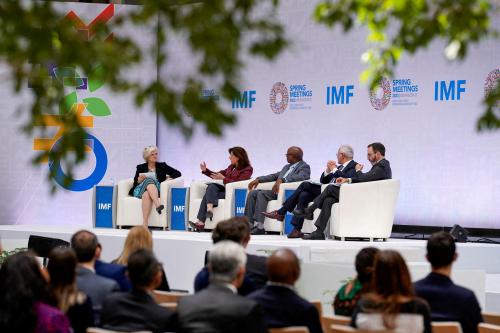Over the past fortnight, India analysts have vied to offer the most compelling explanation of the country’s grim economic data—slowing GDP growth and a depreciating currency—and to identify policies that might turn these indicators around. Less than two months ago, the same experts were engaged in an equally excitable debate over a more positive set of economic numbers. After more than three decades in which the number of Indians living on under $1.25 a day consistently stood around the 400 million mark, the results from a new national survey unveiled by India’s National Planning Commission showed that this number had shrunk by around 100 million between 2009 and 2011. What had caused poverty to fall so far and so fast?
The two sides of the debate were provocatively captured in the title of an article in the Indian Express: The Great Growth-Dole Trade-off. Either India’s previously strong economic growth was sufficiently inclusive that the poor shared in its gains or expanding basic social welfare programs—in particular the Rural Employment Guarantee Scheme (NREGA) and the food subsidy program—succeeded in reaching and helping many of the poor.
Two visions for ending extreme poverty
This dichotomy has a broader resonance. Today there is growing momentum behind the goal of ending extreme poverty worldwide over the next generation—a goal recently endorsed by the U.N. High Level Panel on the Post-2015 Development Agenda and the World Bank. Behind this agenda are two competing visions for how extreme poverty can be eradicated which mirror the two sides of the Indian debate. One focuses on unlocking the potential for rapid and broad-based development through the economic transformation of poor countries; the other advocates the establishment of a global social safety net.
The distinction can be carried too far. The two visions are not mutually exclusive: they can be acted on simultaneously and can serve to reinforce each other. A social welfare program that guarantees adequate levels of nutrition, education and health provides the foundations for a productive and skilled labor force to drive economic activity and entrepreneurship. Conversely, a growing economy generates additional government revenues, which can be used to finance more comprehensive social protection.
Nevertheless, it is interesting to ask which vision offers the more likely path to a poverty-free world.
A recent study published by the World Bank provides some insights on this question. The authors analyze over a dozen countries that recorded a large decrease in poverty over the past decade. In each case they develop counterfactual simulations to determine the main drivers of poverty reduction. These drivers can be organized into three groups: increased labor income, whether as a result of increased wages or employment; increased non-labor income, reflecting social transfers, subsidies and remittances; and other factors, which include the demographic composition of households and their propensity to consume. The contribution of each set of drivers can then be quantified. (Note that this type of accounting exercise captures the proximate routes out of poverty but cannot explain the causes of poverty reduction, which would require an understanding of the relationships between different drivers.)
Source: Azevedo, Joao Pedro, Gabriela Inchauste, Sergio Olivieri, Jaime Saavedra and Hernan Winkler. April 2013. “Is Labor Income Responsible for Poverty Reduction? A Decomposition Approach.” Policy Research Working Paper #WPS 6414. World Bank.
Figure 1 illustrates the contribution of the three sets of drivers to the reduction in $1.25 poverty recorded in each country. The results indicate that labor and non-labor income together account for the bulk of poverty reduction in all countries, but that the relative importance of each differs from country to country. In Bangladesh, Nepal and Peru, labor income, reflective of growing economic activity, was the predominant route out of poverty. In Argentina, Costa Rica and Moldova, public and private transfers played the leading role. In Brazil, Ecuador and Panama, both sets of drivers were significant. Aggregating across the results, labor income can claim a marginally greater role than non-labor income but the difference is small. In terms of the two visions for ending extreme poverty—inclusive growth or social transfers—both appear validated in equal measure.
Prospects for 2030
If that’s the past 10 years, what about the next 20? There are reasons to believe that the prospects for poverty reduction associated with each of these paths could change over time.
Consider first growth prospects. The last decade has seen a dramatic take-off in economic performance across much of the developing world with more countries converging with Western income levels, and convergence taking place at a much faster rate. Instances of super-charged catch-up are also becoming more common. Five years ago, the Growth Commission was able to identify only 13 countries that had experienced fast, sustained economic growth (averaging 7 percent or more over 25 years or longer) in the post-war period. If IMF growth forecasts are met, nine more countries, including five from Africa, will be added to this list by 2018.
Whether the turnaround in developing economy performance will be sustained is an ongoing question. One factor behind this turnaround, which there is every reason to believe is permanent, is the growing reverence for and practice of good economic governance across the developing world, such that fiscal balance, price stability, sustainable debt levels and current account balance are now the norm, including in many of the world’s poorest countries. (India’s macroeconomic ill-health looks decidedly tame compared to any historical benchmark.)
The rise of the global middle class will lead to an explosion in the demand for consumer goods creating manufacturing opportunities in which many countries can conceivably share.
Questions have also been raised about the quality or inclusivity of growth in developing economies. The long boom in commodity prices has served as a catalyst for growth in some economies, especially in Africa, but resource extraction creates few jobs. The tried and tested model of inclusive development associated with East Asia’s economic miracle may become harder for others to emulate as supply chains unbundle and globalize, and as technology renders manufacturing increasingly capital and skill intensive. On the flipside, the rise of the global middle class will lead to an explosion in the demand for consumer goods creating manufacturing opportunities in which many countries can conceivably share.
Social transfers have enjoyed their own ascent in the developing world over the past decade. Inspired by the success of such programs in Brazil and Mexico, more than 40 developing countries are now experimenting with or establishing programs of their own. An estimated 750 million to 1 billion people are today beneficiaries of cash transfers in the developing world. A combination of new technologies—identification, communication, payment, digitalization and data processing—are being applied to make transfer programs easier to administer, more affordable and better targeted. And where governments show little appetite for establishing transfer programs, it has been shown that NGOs could conceivably pick up the slack.
However, for all the promise of social transfers, we remain a long way away from the establishment of a global social protection floor. In Brazil and Mexico where programs are at scale but impose conditions, it is notable that extreme poverty persists at a low level.
The relationship between poverty reduction and global development
Nevertheless, the attraction of social transfer programs is that they allow the goal of ending extreme poverty to be separated from the more ambitious but elusive quest for broader transformation with which global development is ultimately concerned. Inevitably some developing economies will struggle to grow consistently and to create good jobs over the next 20 years. In others, a fraction of the poor will remain excluded from the benefits of growth. In these cases, the potential for poverty reduction lies disproportionately with transfers.
In his excellent book, Getting Better, Charles Kenny documents the improvements in quality of life that have been recorded across the world, even in places where incomes have been stagnant. While advances in education, health and rights were possible over the past century despite the persistence of poverty, today it may be possible to eliminate extreme poverty despite the absence of development.
Poverty modeling exercises show that sustained, inclusive growth can drive massive progress in poverty reduction over the next 20 years.
Poverty modeling exercises show that sustained, inclusive growth can drive massive progress in poverty reduction over the next 20 years. But they also reveal the limitations to this approach as the rate of global poverty approaches zero.
As poverty decreases, the share of the world’s poor living in fragile states is expected to rise. These are countries that by definition are prone to erratic, start-stop growth and where the benefits from growth episodes can quickly be undone during periodic reversals. Another group whose chances of making it out of poverty through inclusive growth are slim is those individuals who currently stand furthest below the poverty line. Of the 1.2 billion people living on under $1.25 around the world, 300 million survive on less than 70 cents a day and two-thirds of these are in Africa. Evidence from the World Bank study attests that the further individuals stand below the poverty line, the more reliant they are on transfers as the only feasible fast-track route out of poverty.
The best chance for ending extreme poverty over the next generation is to reconcile these two visions. The most viable route out of poverty for any individual below the poverty line depends on their particular circumstances. Neither an inclusive growth nor a social protection strategy can succeed on its own in all settings. Both strategies require greater support if they’re to be realized.





Commentary
Op-edA World Free of Extreme Poverty – But by Which Path?
September 17, 2013